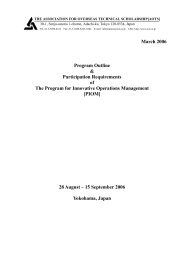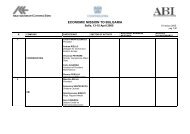Analysis of the Operation and Financial Condition of the Enterprise
Analysis of the Operation and Financial Condition of the Enterprise
Analysis of the Operation and Financial Condition of the Enterprise
You also want an ePaper? Increase the reach of your titles
YUMPU automatically turns print PDFs into web optimized ePapers that Google loves.
<strong>Analysis</strong> <strong>of</strong> <strong>the</strong> <strong>Operation</strong> <strong>and</strong> <strong>Financial</strong> <strong>Condition</strong> <strong>of</strong> <strong>the</strong> <strong>Enterprise</strong>statement vertical analysis all items are expressed against <strong>the</strong> amount <strong>of</strong> revenues <strong>and</strong>costs. Horizontal analysis – <strong>the</strong> relative <strong>and</strong> absolute changes in various items <strong>of</strong> <strong>the</strong>statements compared to <strong>the</strong> preceding period or any o<strong>the</strong>r base periods areidentified. By using this method it is possible to analyse both indicators during <strong>the</strong>change period <strong>and</strong> <strong>the</strong> variance <strong>of</strong> <strong>the</strong> indicators compared to <strong>the</strong> base period. Themethod <strong>of</strong> dynamics shows <strong>the</strong> trends <strong>of</strong> changes in <strong>the</strong> indicators under review <strong>and</strong>gives <strong>the</strong> possibility in <strong>the</strong> course <strong>of</strong> analysis to study <strong>the</strong> influence <strong>of</strong> differentfactors on <strong>the</strong> changes in <strong>the</strong> given indicators <strong>and</strong> to determine <strong>the</strong>ir value.Horizontal analysis is based on <strong>the</strong> golden rules <strong>of</strong> <strong>the</strong> balance sheet. The balancesheet golden rules are not m<strong>and</strong>atory; <strong>the</strong>se are recommendations on how to do <strong>the</strong>financing <strong>of</strong> assets.Three golden rules <strong>of</strong> <strong>the</strong> balance sheet exist:1. Equity – long-term investments = deviation(2.1)This means that it is desirable to cover long-term investments by equity (equityis held by an enterprise for an unlimited period <strong>of</strong> time).2. (Equity + long-term liabilities – long-term investments = deviation(2.2)Long-term investments should be covered by equity <strong>and</strong> long-term liabilities,because <strong>the</strong> long-term liabilities are due in one year <strong>and</strong> more.3. Short-term liabilities – Working capital = deviation (2.3)This means that working capital should be covered by short-term liabilities.The basic idea <strong>of</strong> <strong>the</strong> horizontal or dynamic analysis method is to compare <strong>the</strong> values <strong>of</strong><strong>the</strong> indicators under review with <strong>the</strong> values <strong>of</strong> <strong>the</strong> same indicators in <strong>the</strong> preceding period (<strong>the</strong>base period) or with <strong>the</strong> values included in <strong>the</strong> budget.Horizontal analysis: Gives an idea <strong>of</strong> <strong>the</strong> enterprise rate <strong>of</strong> growth, <strong>the</strong> proportion between <strong>the</strong>growth rates <strong>of</strong> <strong>the</strong> enterprise income <strong>and</strong> expenditure; Allows to clarify <strong>the</strong> trends <strong>of</strong> development <strong>of</strong> <strong>the</strong> enterprise <strong>and</strong> <strong>the</strong>ir cyclicalnature, <strong>the</strong> influence <strong>of</strong> internal <strong>and</strong> external factors on enterprise performanceresults; Allows to asses <strong>the</strong> efficiency <strong>of</strong> growth in <strong>the</strong> turnover <strong>of</strong> an enterprise inrelation to its financial status.The dynamic or horizontal analysis shows <strong>the</strong> trends <strong>of</strong> changes in <strong>the</strong> indicators underreview <strong>and</strong> gives <strong>the</strong> possibility in <strong>the</strong> course <strong>of</strong> analysis to study <strong>the</strong> influence <strong>of</strong> differentfactors on <strong>the</strong> changes in <strong>the</strong> given indicators <strong>and</strong> to determine <strong>the</strong>ir value. This type <strong>of</strong>analysis can be carried out as certain changes in some balance sheet items in absolute <strong>and</strong>relative figures (percentages) when <strong>the</strong> indicators <strong>of</strong> <strong>the</strong> reporting period are compared to <strong>the</strong>previous period or any o<strong>the</strong>r base indicators. Changes are analysed with <strong>the</strong> help <strong>of</strong> <strong>the</strong>dynamics index or in percent.Horizontal variances <strong>of</strong> <strong>the</strong> financial indicators are expressed as follows:Dynamics index (DI) = Reporting period indicator/base period indicator (2.4)43
















